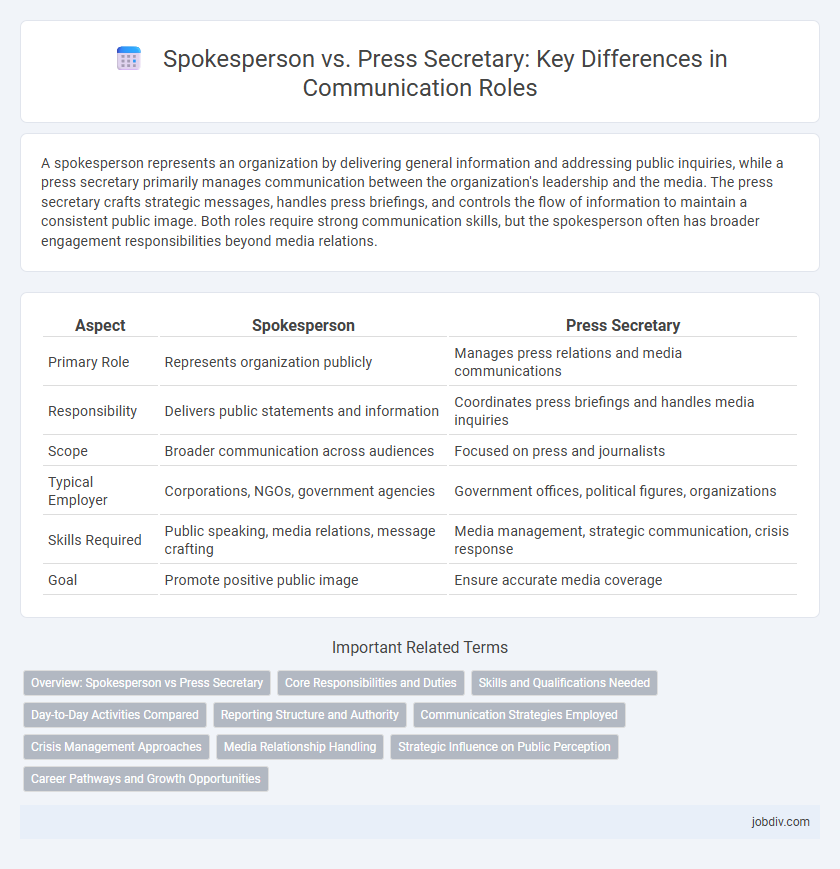A spokesperson represents an organization by delivering general information and addressing public inquiries, while a press secretary primarily manages communication between the organization's leadership and the media. The press secretary crafts strategic messages, handles press briefings, and controls the flow of information to maintain a consistent public image. Both roles require strong communication skills, but the spokesperson often has broader engagement responsibilities beyond media relations.
Table of Comparison
| Aspect | Spokesperson | Press Secretary |
|---|---|---|
| Primary Role | Represents organization publicly | Manages press relations and media communications |
| Responsibility | Delivers public statements and information | Coordinates press briefings and handles media inquiries |
| Scope | Broader communication across audiences | Focused on press and journalists |
| Typical Employer | Corporations, NGOs, government agencies | Government offices, political figures, organizations |
| Skills Required | Public speaking, media relations, message crafting | Media management, strategic communication, crisis response |
| Goal | Promote positive public image | Ensure accurate media coverage |
Overview: Spokesperson vs Press Secretary
A spokesperson serves as the official voice of an organization, communicating key messages and responding to public inquiries, while a press secretary primarily manages media relations and crafts official statements for senior officials. The spokesperson often handles broader communication responsibilities, including public appearances and crisis communication, whereas the press secretary focuses on press briefings and coordinating with journalists. Both roles are essential for maintaining consistent messaging, but the press secretary is more specialized in media strategy and spokesperson's domain covers wider public engagement.
Core Responsibilities and Duties
A spokesperson primarily represents an organization in public communications, delivering official statements and addressing media inquiries to shape public perception. A press secretary manages the flow of information between executives and the media, coordinating press releases, briefing journalists, and organizing press conferences. Both roles require strong messaging skills, but the spokesperson focuses on external communication, while the press secretary handles internal media coordination and strategic communication planning.
Skills and Qualifications Needed
A spokesperson requires exceptional verbal communication skills, media savvy, and the ability to present information clearly and persuasively to diverse audiences. A press secretary must possess strong organizational skills, crisis management experience, and expertise in crafting strategic messages under pressure. Both roles demand proficiency in public relations, strong interpersonal abilities, and a deep understanding of the organization's objectives and policies.
Day-to-Day Activities Compared
A Spokesperson primarily manages public communication by delivering official statements and addressing media inquiries, focusing on clear message dissemination. A Press Secretary handles daily coordination with the press, organizing briefings, preparing talking points, and managing the flow of information within an organization. Both roles are essential for maintaining consistent and accurate communication between an entity and the public or media outlets.
Reporting Structure and Authority
A spokesperson typically reports to the communications director or chief communications officer and serves as the official voice of an organization, authorized to address the media and public on various topics. In contrast, a press secretary often operates within political or governmental settings, reporting directly to a senior official such as a president or minister, with authority centered on managing press relations and delivering official statements. The press secretary's role usually carries a higher degree of direct influence over day-to-day communication strategy and message control within the executive office.
Communication Strategies Employed
Spokespersons employ broad communication strategies to represent an organization's message consistently across diverse media platforms, emphasizing clarity and adaptability for various audience segments. Press Secretaries focus on managing daily press interactions, crafting precise messaging to handle immediate inquiries and maintain a controlled narrative during fast-paced news cycles. Both roles utilize media monitoring, targeted messaging, and crisis communication tactics to shape public perception effectively.
Crisis Management Approaches
A spokesperson serves as the public voice of an organization, delivering consistent messaging during crisis situations to maintain trust and transparency. Press secretaries manage media relations and coordinate information flow, ensuring accurate and timely updates to mitigate misinformation. Effective crisis management requires spokespersons to convey empathy and clarity, while press secretaries handle strategic communication logistics.
Media Relationship Handling
A spokesperson serves as the official voice representing an organization's stance to the media, often addressing a wider range of public inquiries and delivering key messages during crises or events. A press secretary primarily manages daily interactions with journalists, organizes press briefings, and ensures consistent, timely dissemination of information to maintain a positive media relationship. Effective media relationship handling requires both roles to coordinate messaging strategies, respond promptly to inquiries, and build trust with reporters to shape public perception.
Strategic Influence on Public Perception
A spokesperson shapes public perception by delivering consistent and clear messaging that aligns with an organization's brand identity, enhancing trust and credibility among target audiences. A press secretary strategically manages media relations, crafting responses and controlling information flow to influence public narratives and maintain a favorable image for political figures or institutions. Both roles employ effective communication tactics to strategically influence public perception, but the spokesperson emphasizes branding while the press secretary focuses on media strategy.
Career Pathways and Growth Opportunities
A spokesperson typically builds a career by developing expertise in public relations, media communications, and brand messaging, often advancing through roles in corporate, nonprofit, or government settings. Press secretaries usually follow a political or governmental pathway, gaining experience in legislative affairs, policy communication, and crisis management, with opportunities to progress into senior advisory or communications director roles. Both careers offer growth through expanding media networks, strategic communication skills, and leadership responsibilities in diverse organizational environments.
Spokesperson vs Press Secretary Infographic

 jobdiv.com
jobdiv.com